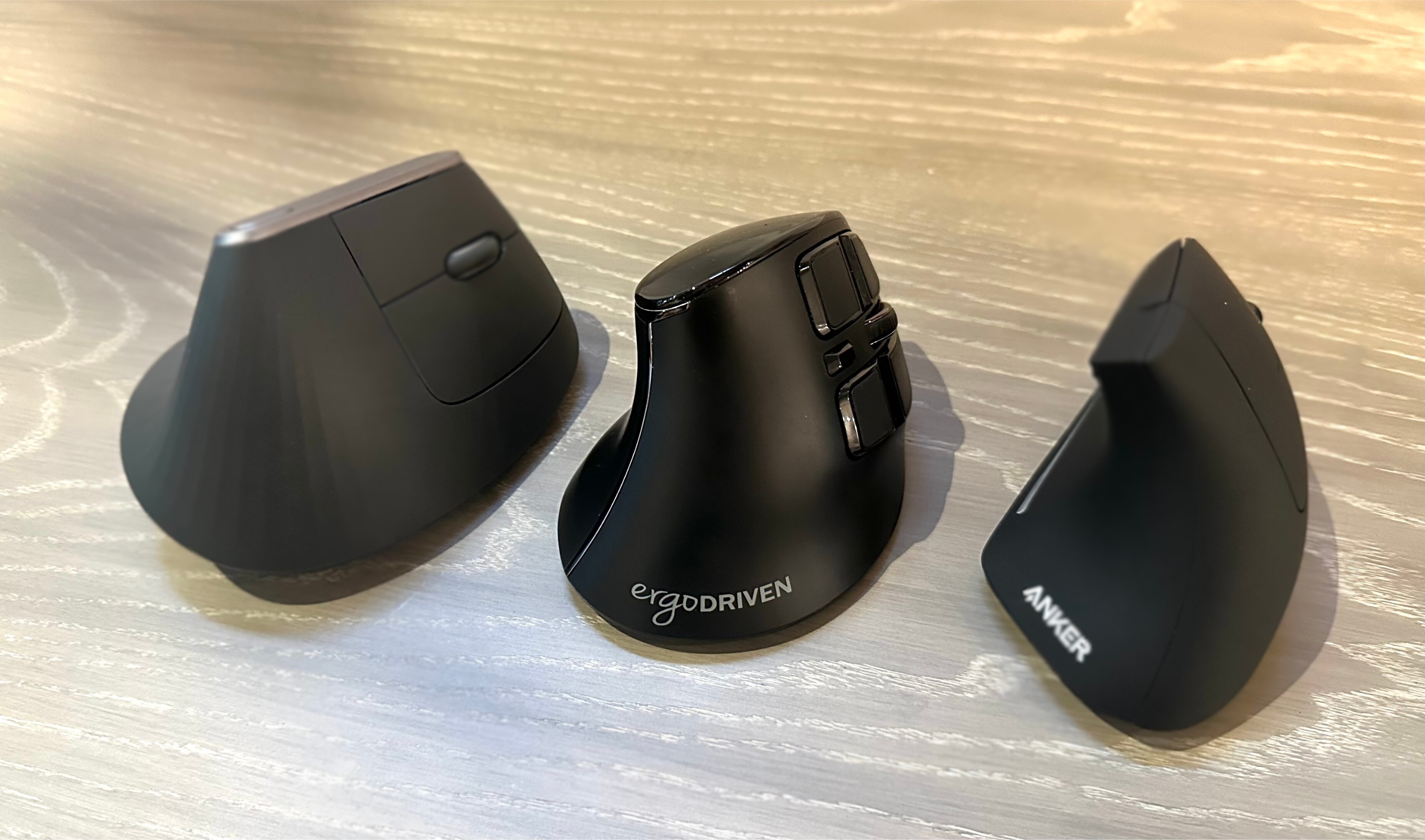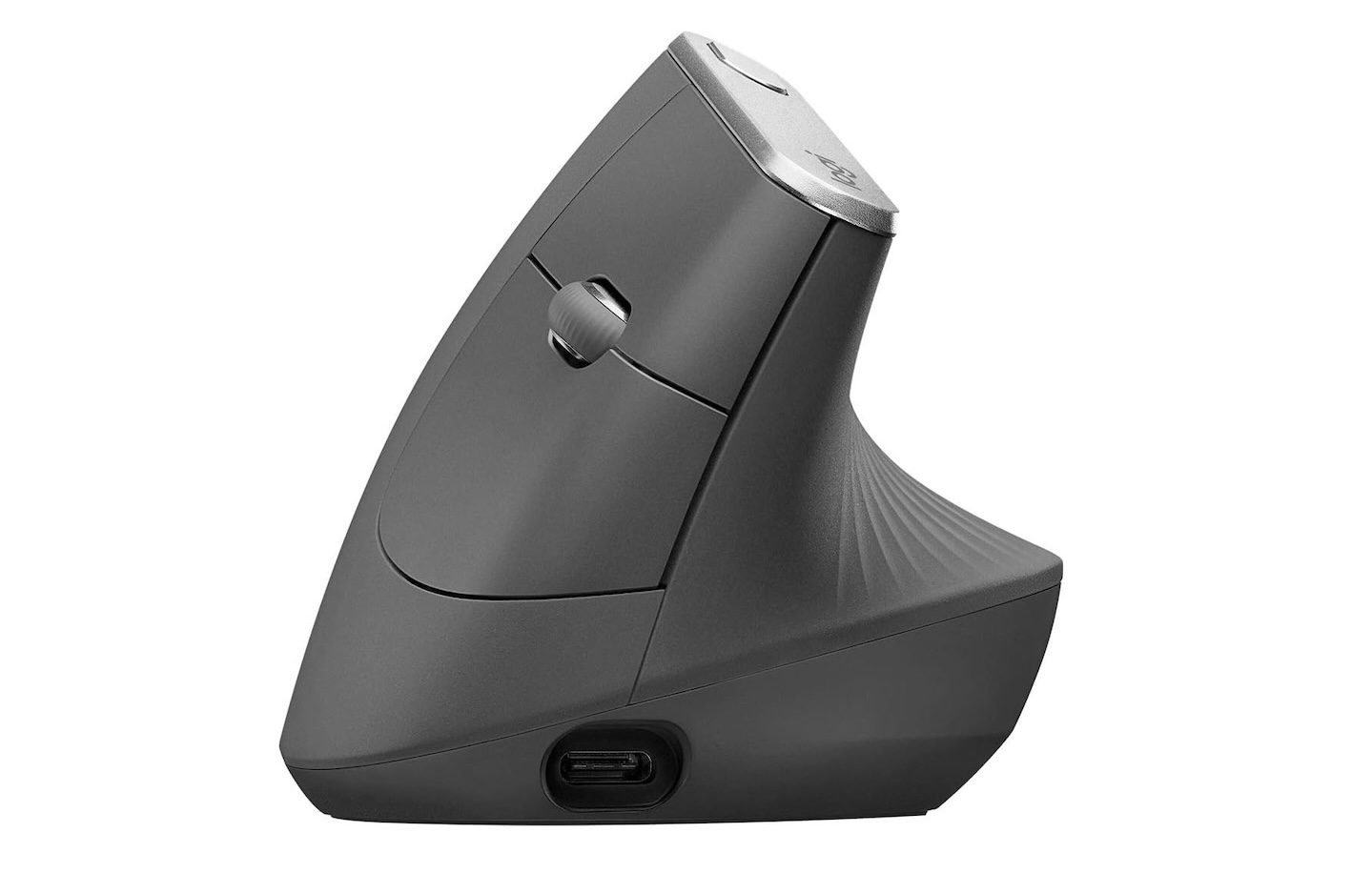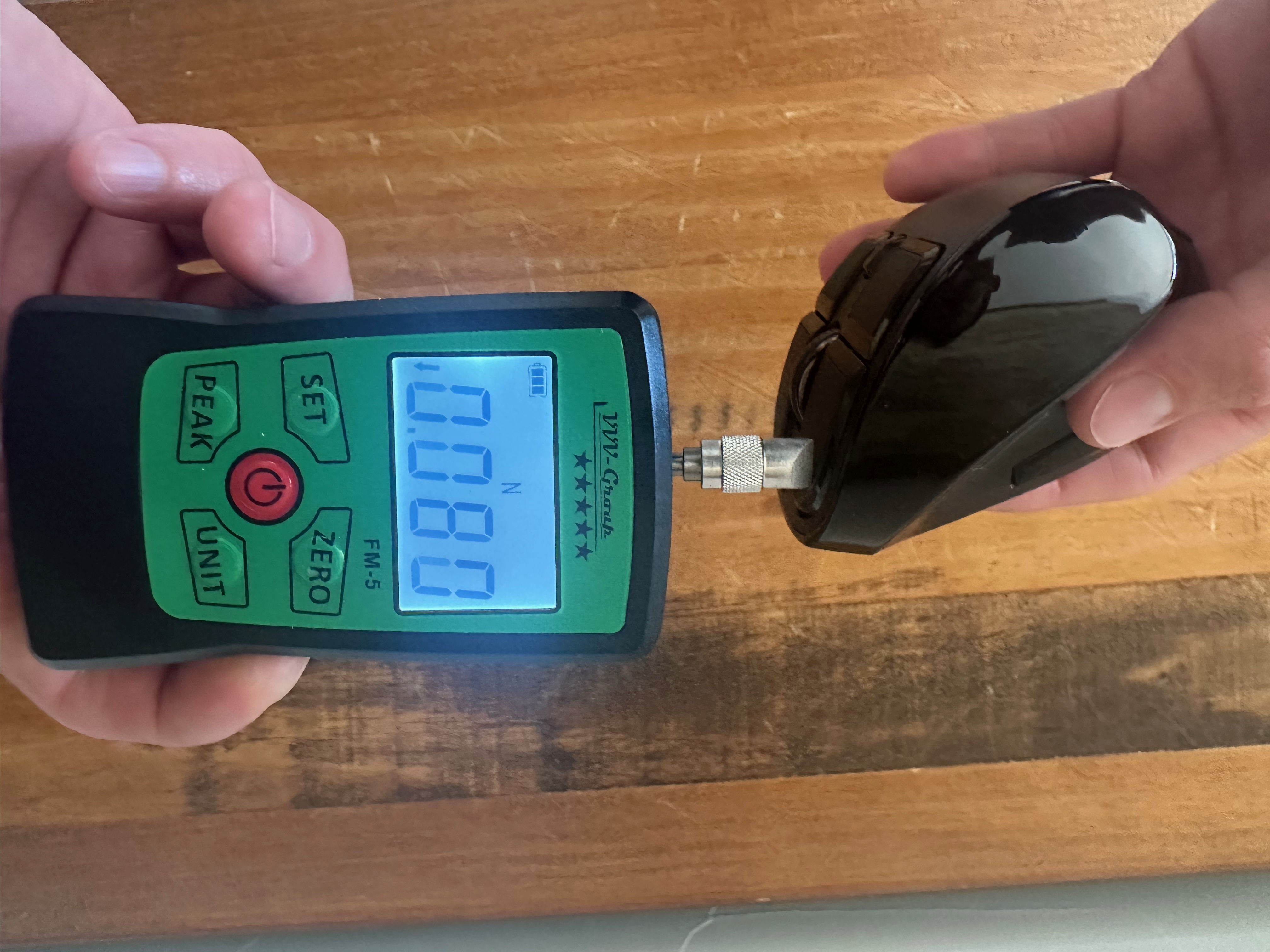Deal Alert: Top Pick Om Mouse $10 Off Today Here
Last updated: August 2025
Ergodriven vs Logitech vs Anker: Comparing the 3 Top Ergonomic Mice
Words by
Justin Walz, Ph.D.

Share



Published on: Apr 29, 2025

Vertical mice are widely regarded as the healthiest option - but which of the Top 3 is best for you?
Wellness Reviews is a series in which contributing health and fitness (and in this case biomechanics) experts review the products that help us feel our best.
When I first got into the field of ergonomics, everyone was using mice with big red thumb balls (remember those?).
And even though it means I'm getting older, I am glad those days are gone.
We've known for over a decade now that a vertical (or "handshake" style) mouse is best for your body.
In the last few years, manufacturers have really caught up to that - so there are some really great options on the market.
After testing dozens of mice, we've narrowed it down to the two best options.
And we've added one more mouse to this review, because even though it's awful, tons of people buy it! So we want to make sure we warn you NOT to get that one.
Our Top Pick
$10 Off

Ergodriven
Om Vertical Mouse
Best for most people. Silent, micro-force buttons are impressive.
$ 39
$10 Off at Ergodriven
Code
Alternate Option

Logitech
MX Vertical
Best if you have really large hands (6'4" or taller). Wait for a sale!
$102.90
$102.90 at Amazon
Should I get a vertical mouse?
In a word - probably.
If you use your computer mouse for more than a couple hours per week (who doesn't?), it is definitely worth upgrading.
Even though we all used them for years, standard flat computer mice actually put your body in a really nasty, unnatural position.
They force your shoulder into what's called "internal rotation" causing shoulder, neck, and upper back tension and pain. And because you have to bend your wrist up over the mouse - right where your wrist contacts the desk - they are also likely to cause carpal tunnel syndrome.
Vertical mice are widely accepted as the ergonomic ideal because they correct these issues, by keeping your body in a more natural position.
If you're really interested in the biomechanics, you can read more here. But it's ok to just take away that vertical = healthier!
What to look for in a vertical ergonomic mouse
Everybody (and every body) is different - but we also have a lot in common. We are looking for a mouse that's slanted at about 30 degrees from vertical (or 60 degrees from horizontal).
We also want to be well sculpted for a range of hand sizes. Those with large hands may use their fingertips more, vs smaller hands using their palm a bit more on the mouse.
Lastly - and one that's overlooked a lot by designers - we want our fingers to be in a neutral position on the mouse. We'll cover this in depth.

Best Overall - Om Mouse
The Om Mouse wins best overall because it has a great shape, the primary buttons are silent and absurdly easy to click, and it comes in at an unbelievably low price point for its quality.
Connectivity is reliable in either Bluetooth or with the 2.4g USB dongle. The screen is a nice touch for setting DPI (an underrated ergonomic factor) and monitoring the charge level of the long-life rechargeable battery.
The screen also enables another cool feature - assigning custom functions right on the mouse. You don't have to download software to map the function buttons - a critical feature for anyone whose office restricts that sort of thing, and a convenient plus for the rest of us.
I do a lot of copy pasting, and it took me about 10 seconds to assign "copy" to one button and "paste" to another. Very cool. I also like having "mic mute" assigned to the lower thumb button so I can easily mute and unmute myself on zoom calls.
Om's Ideal Shape
Viewed from the front, Om is tilted up at an angle of ~60deg, right in the middle of the ideal range. Looking down from the top, you can see that Om allows your hand to curl naturally (a big minus for the Logitech mice).
And looking from the side, Om allows for a neutral wrist angle across a wide range of arm angles. Again, a nice contrast to the Logitech mouse that forces your hand into a downward tilt.
Micro-Force Buttons
Om's marketing material makes a big deal about the "micro-force buttons" and "ultra-low click force". And we can confirm that this is both very important and done incredibly well on this mouse.

It's important because on a vertical mouse, any force that the user imparts to click must be opposed by an equal and opposite force from the thumb. Keeping your thumb muscles contracted like this adds unnecessary fatigue and tension.
So the more you can reduce the click force, the better. This is where the Anker fails massively.
Om's click force is almost unbelievably low. And the clicks are totally silent, which imparts a very high quality feel.

These micro-force clicks on Om are achieved with a two-prong effort. First, the actual switch itself (the electronic component inside the mouse) is the lowest force microswitch available on the market. And second, the engineering of the button itself (the molded plastic that you actually touch), which increases your lever arm smoothly across the range of the switch.
The result is a very impressive mouse experience - clicks are just hard enough that you know you're doing it and don't click accidentally. It would feel nice on any mouse, but on a vertical mouse it really improves the whole experience.
A surprisingly useful screen
When we first heard that this mouse had an onboard OLED screen, we were skeptical to say the least.
But it's actually surprisingly useful!
In normal operation, the screen shows the battery charge level, the chosen DPI, and the connection status. Since Om has a rechargeable battery, it's nice to know the charge level so you aren't caught off guard by the sudden need to charge. Although the battery lasts a long time (over a month in our testing) and you can still use the mouse while charging.

For Any Mouse - A Note about DPI
DPI is short for "dots per inch". On a mouse, it measures how far across the screen your cursor moves when you move the mouse an inch.
You can also set a "speed" for your cursor on your computer side. But if possible, it's best to leave that in the center of the range and adjust it on the mouse instead.
DPI is massively overlooked when it comes to ergonomics. You want to be able to mouse all the way from one corner of your display(s) to the diagonally opposite corner without picking up your mouse. But you also want to be able to click on your intended target accurately without effort.
Set your DPI too low, and you'll have to pick up your mouse a lot. Set it too high, and you'll be straining your focus to click on the right link without accidentally zooming past it.
Surveys consistently show that almost everyone has their DPI set incorrectly, many people don't know what it is, and most are afraid to change it - for fear they can never get back to "good enough".
In that sense, it's nice that Om shows the DPI right on the screen - so you can adjust and tune it in confidence.
Interesting approach to custom functions
Most professional-grade mice have some additional buttons, and allow for you to assign custom functions to them.
This is typically done with additional software installed on your computer. You can download and install that software, then set on the computer what you want the custom buttons to trigger when pressed.
Om goes about this a unique way. There is no software to install (a big plus for people whose jobs don't allow third-party software, like government employees). Instead, you use a menu right on the mouse to select which of 30+ custom functions you'd like to assign to each button.
It works really well (so long as the function you want is on the list, as most common ones are). After running through the process once or twice, it was easy to remember, and I was able to assign custom functions in less than 10 seconds.
Click Here to Get $10 Off Om Today

For the Biggest Hands - Logitech MX Vertical
The MX Vertical is a solid mouse on paper, but or testers found it to be much too large. In addition to the mouse's large size - the shape doesn't allow your fingers to curl naturally unless you have very large hands.
Our tallest tester was 6'4", and he found the MX Vertical more comfortable than the Om - though lamented that the Logitech mouse wasn't as easy to click.
All other testers, even a few who are over 6' tall, preferred the size and shape of the Om mouse.
Please Don't Buy This Mouse - Anker Vertical
We've never put a "Don't Buy" section in a review before, but this mouse deserves it. Thanks to the momentum built up in over a decade on Amazon, this mouse still sells quite a lot.
But I have no doubt it is turning a lot of people off from the concept of vertical mice altogether. This mouse is loud, light, cheaply made - and worst of all it is almost comically hard to click.
Parting Thoughts
Vertical mice are widely agreed upon as the best option for your body by ergonomists, occupational therapist, and biomechanists alike.
This is the way mice should have been designed from the start.
Even if you don't have neck pain, shoulder pain, or carpal tunnel syndrome from your current mouse yet - it's worth the relatively small investment to make sure you stay healthy while you work.
And if you do already have pain - now is the time to eliminate it.
All of our recommendations have at least a 30-day trial period, and Om has a 90-day window, with totally free returns. So go ahead and try healthier mousing right now, risk-free.
Our Top Pick
$10 Off

Ergodriven
Om Vertical Mouse
Best for most people. Silent, micro-force buttons are impressive.
$ 39
$10 Off at Ergodriven
Code
Alternate Option

Logitech
MX Vertical
Best if you have really large hands (6'4" or taller). Wait for a sale!
$102.90
